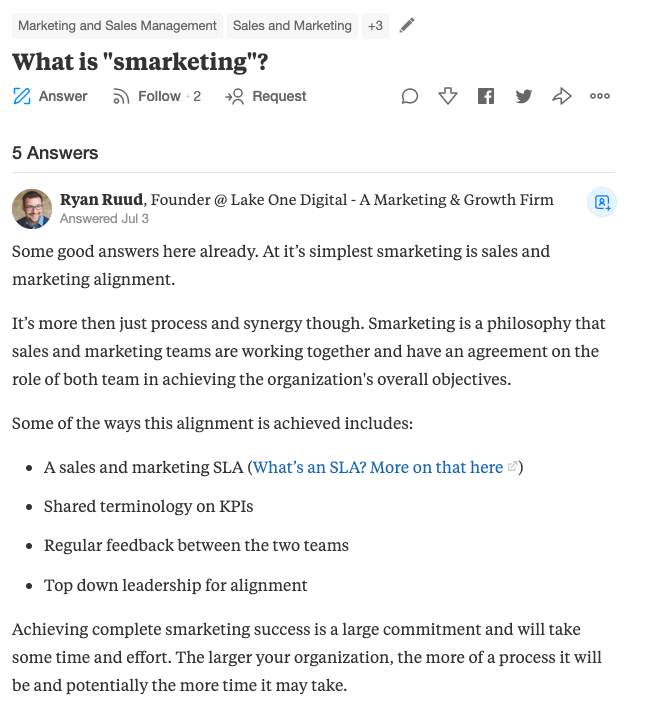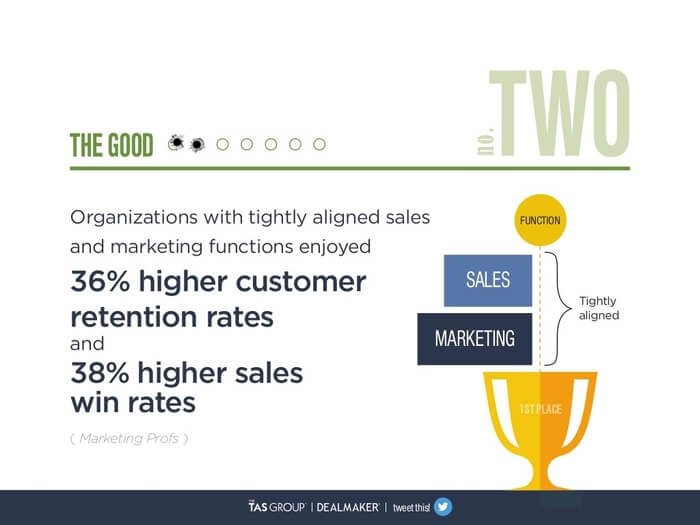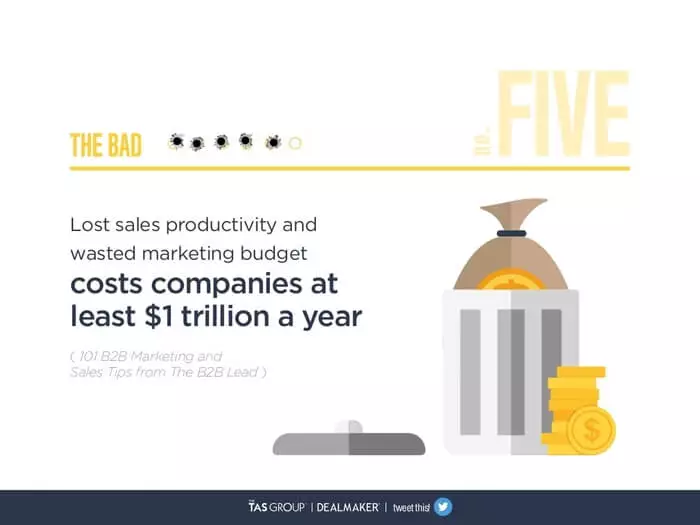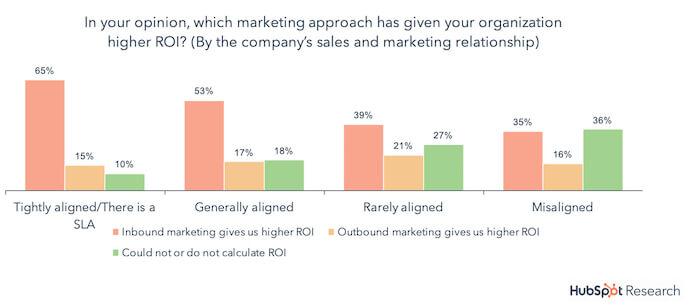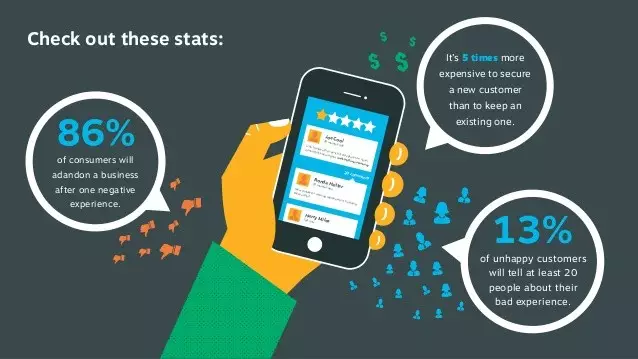It is a long-standing industry tradition to treat marketing and sales as two separate activities, each governed by its own rules, strategies, and goals. If you look at how most companies are organized in practice – you’ll see the power of smarketing.
On one side, there is the marketing department which is tasked with creating promotional materials, spreading brand awareness, and communicating with consumers on a large scale. On the other side, there is the sales department, whose role is to generate revenue directly by convincing prospects to buy products and services.
There is nothing inherently wrong with treating sales and marketing as two separate entities. This way of thinking has its roots in traditional economic theory, specifically in the idea of division of labor. The assumption here is that breaking up the work process into smaller, independent activities will lead to productivity gains. However, in the specific case of sales and marketing, this kind of division is more difficult to uphold.
In the age of fast-paced, data-driven commerce, letting each department operate independently is no longer recommended. It is now increasingly common to hear marketing departments complaining about how sales teams don’t properly follow up on the leads they provide.
Similarly, sales departments blame marketers for creating insufficiently qualified leads, making their job unnecessarily difficult. This is a clear sign that the separation between marketing and sales has run its course, and that an attempt should be made to bring the two closer together.
Here’s what Ryan Ruud, Founder @ Lake One Digital opinion is:
‘Smarketing’ is one such attempt. A portmanteau of ‘sales’ and ‘marketing’, smarketing is the idea that sales and marketing departments should act as a single unit. This is to be achieved through a process called marketing-sales alignment. If you wish to know more about how you can harness the power of smarketing for your organization, check out our short primer on the topic in the remainder of this article.
Why smarketing works
Smarketing has one essential purpose – aligning sales and marketing to improve your revenue stream. Despite being a relatively recent development, smarketing already has a good track record at accomplishing these goals. According to HubSpot:
- Failing to align marketing and sales can cost companies 10% revenue per year
- Companies that do align sales and marketing have 208% higher marketing ROI
- Smarketing has helped companies achieve 36% higher sales close rate and 38% higher customer retention
Source:blog.hubspot.com
Smarketing is clearly effective at achieving its designated goal. And to understand why this is the case, we need to examine the principles behind its functioning. To put it simply, smarketing works as a strategy because it assumes that sales and marketing are two aspects of the same underlying activity.
The role of marketing is to generate an inflow of qualified leads. The purpose of sales is to turn these leads into paying customers. The distinction between the two is clearly artificial and only serves to weaken the effectiveness of both sales and marketing.
Marketing teams that don’t cooperate with sales teams will generate leads that are hard to convert, which creates extra work for the latter. Similarly, sales teams that work independently of marketing won’t be able to provide useful sales data to the latter to create better marketing materials.
If the two worked together instead, they could downplay their weaknesses and emphasize their strengths, which would create a more consistent conversion pipeline, which in turn would lead to more profit.
Smarketing in practice
Source:blog.hubspot.com
There are multiple ways to implement a smarketing business system. Smarketing is flexible by definition – all strategies that work towards marketing-sales alignment are valid. To help you get started, we will outline a few of the most common ones, and then it is up to you to pick and use the ones that suit your specific business needs.
1. Enable data-sharing between teams
Both marketing and sales teams rely on digital data to accomplish their respective tasks. So the first thing you can do to synchronize their efforts is to ensure they have access to the same data. Sales teams that have access to quality lead data such as their name, contact numbers, valid email IDs (that you could get using an email finder), social profiles etc, can find out which style of narrative is best suited for which customer segment. Conversely, marketing teams armed with sales data will have an easier time writing suitable marketing content.
To enable smarketing data-sharing within your organization, you will need the right kind of software. Cloud storage solutions will streamline the sharing of documents, statistics, conversation logs, and other forms of data. A CRM software is also useful for keeping data synchronized between teams, as well as for coordinating their activity. Find out which CRM is best for your teams to work together.
2. Adopt a unified terminology
Both marketing and sales have their own terminology for describing what they do. There is a lot of overlap between the two. But there are also terms which have a completely different meaning depending on who you ask. This can create a barrier to the project implementation of smarketing. And the way to overcome is to adopt a smarketing vocabulary both teams are comfortable with.
A shared terminology will allow sales and marketing teams to avoid problems arising due to misunderstandings.
In addition to defining terms such as ‘lead’, ‘conversion’, or ‘top of the funnel’, this common vocabulary should include smarketing-specific terms such as ‘ideal customer profile’ (ICP). Defining ICP is crucial for marketing-sales alignment because it ensures that both teams or on the same page with regards to their principal target. More on this later.
3. Create a service level agreement
Source:https://blog.hubspot.com
Sales and marketing teams operate according to different benchmarks. And if one of them fails to meet their obligations, both teams will inevitably suffer for it. To ensure that this doesn’t happen, sales and marketing teams can opt to create a service level agreement (SLA).
An SLA is just a document that establishes the obligations each team has to fulfill in a given period. Typically it includes information such as a conversion time-frame, the definition of a sales-ready lead, and the criteria for when a lead is to be passed on from marketing to sales. The purpose of an SLA is to provide a performance baseline for each team, so they can synchronize more easily.
Having an SLA in place will ensure that sales and marketing teams operate under the same rules from the outset.
4. Communicate in person with Smarketing.
It’s a team endeavor, and communication is the glue that holds a team together. The most effective way to foster communication between sales and marketing people is to create opportunities for talking in person. Regular talking sessions in a shared environment will allow the two departments to strengthen their relationship by getting to know each other better.
Other, less formal modes of interaction such as going out together after work, attending seminars, or going on a group excursion can also have a positive effect on communication. Team morale will also increase in proportion to how comfortable each department members are around each other.
Ultimately, communication is all about teaching people to cooperate with each other instead of competing.
5. Unify content creation
Content is the lifeblood of smarketing. Both marketing and sales rely on it to fulfill their conversion-related tasks. However, sales and marketing don’t usually collaborate for content creation, which is one of the reasons the two became estranged. That is why smarketing puts so much emphasis on creating content as a cohesive group.
By unifying the content creation process, message consistency will improve across both sales and marketing channels, leading to more seamless conversions, more engaging brand storytelling, and greater customer loyalty. Customers respond favorably to a brand that has a consistent voice, and they will be more keen on conducting business with such a brand.
Consolidating content creation will also open the door for content reuse, thus reducing the need to have multiple content creators in your company.
BONUS! Here’s a book recommendation from Douglas Burdett on this topic. Tim Hughes, Adam Grey and Hugo Whicher did a great job.
What I’m reading: “Smarketing: How To Achieve Competitive Advantage Through Blended Sales and Marketing” by @Timothy_Hughes, @agsocialmedia, and @HugoW_Oracle (interview coming soon!) https://t.co/OXpmaGBs9W #smarketing #sales #marketing #b2bmarketing pic.twitter.com/2xT93XZ48y
— Douglas Burdett (@MarketingBook) February 10, 2019
6. Find the ideal customer profile with Smarketing
When it comes to smarketing, knowing who you’re marketing and selling to is absolutely critical. If you fail to clarify who is the ideal customer for your company, sales and marketing teams will have trouble implementing their strategies.
Salespeople will end up chasing any lead with the money to buy, and people from marketing will try to appeal to everyone, and end up appealing to no one. To have sales and marketing working together as a team, you need to make them agree on an ICP, and codify it into a document.
This document will be used as a reference whenever there is any uncertainty about a given prospect or lead.
7. Solicit customer feedback
One of the most useful things you can do for marketing-sales alignment is to actively seek out customer feedback. There are many opportunities to do so throughout the conversion process.
Post-sale calls are a great opportunity for discovering the customers’ motivation for choosing your products and services. Consider adding a survey call-to-action on your email signature to collect customer feedback; there are plenty of email signature examples online if you are looking for some inspiration. Feedback gathered in this way will provide you with valuable material for content creation, sales and marketing.
Feedback gathered in this way will provide you with valuable material for content creation, both for sales and for marketing.
It will also enable you to improve your products by learning about use-cases and pain points.
8. Use lead enrichment with Smarketing
Lead enrichment is a frequently overlooked element of the sales process, which is unfortunate since its extremely effective at generating marketing-sales alignment. This is a method of acquiring inside intelligence about leads, giving sales teams more info to work with.
It’s handled by software solutions such as Datanyze and Discover.org, which use their internal database to deliver relevant business intelligence. Staying up to date with lead enrichment will help both your marketing and sales team by giving them additional context about their leads.
9. Use software automation
Smarketing became the dominant force it is today thanks to software automation or RWA automation. One of the best examples of smarketing automation in action is lead routing. Lead routing has given marketing teams the ability to assign qualified leads to appropriate sales team members based on certain criteria, such as their geo-location, funnel placement, or demographic data.
Smarketing automation enables marketing teams to perform a clean lead handoff, streamlining the conversion pipeline, while keeping track of relevant conversion metrics.
10. Employ post-sale nurture
Unifying sales and marketing makes it easier for companies to attract leads and convert them into paying customers, but this is not the only benefit of smarketing. Bringing new customers aboard is much more expensive than retaining existing ones.
So instead of focusing just on bringing new leads, smarketing teams can nurture existing customers to create more revenue through upselling and cross-selling. For instance, after the marketing team acquires a new customer, instead of chasing after the next lead, they could start sending onboarding content to the customer.
Concluding remarks
Aligning sales and marketing through smarketing represents a path forward for companies preparing themselves to face the challenges of the modern market. Future-conscious businesses are increasingly switching over to smarketing. The results speak for themselves – increased revenue, lower operational costs, and more satisfied customers.
And don’t forget, for easy social media collaboration, you’ll always have Planable. Give it a try!
This article was submitted by Daniel Bishop, assistant editor and marketing consultant at ReallySimpleSystems.




